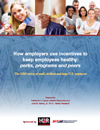Companies Are Investing More in Health-Related Incentives
Study shows that using incentives to boost employee participation in workplace health and wellness programs not only works but pays dividends.
 Employers see well-designed worksite health and wellness programs as strong value even in a down economy. A new, in-depth survey of employers into the use of incentives in corporate wellness programs by Health2 Resources shows that smart investments in employee health programs are yielding results.
Employers see well-designed worksite health and wellness programs as strong value even in a down economy. A new, in-depth survey of employers into the use of incentives in corporate wellness programs by Health2 Resources shows that smart investments in employee health programs are yielding results.
The report, titled “How Employers Use Incentives to Keep Employees Healthy,” shows that paying employees to participate in worksite health and wellness programs is almost uniformly believed among employers of all sizes, with and without programs in place, to boost program success and return value. Almost two out of three U.S. companies offer programs to keep employees healthy, and 66 percent of those offering programs also use incentives, with a healthy number showing an ROI of greater than $1 for each dollar spent.
Among the key findings of the study are:
- Perks matter. The value of incentives is up, averaging $329 in 2009 and ranging from $1 per pound for weight loss to annual premium reductions valued at more than $1,500. The most commonly used incentive is premium reductions, followed by merchandise/tokens and gift cards.
- Employers offer cash, gift cards to spouses and family to keep them healthy. More than half of the companies surveyed offer health and wellness or disease management programs to spouses.
- Confidential health history/questionnaire is an important starting point for worksite wellness. Incentives to take the questionnaire range up to $300 annually, with about 10 to 15 percent exceeding $300.
- Company size matters, but doesn't dictate value of incentives. Some organizations with as few as 210 employees are offering incentives valued at $1,450 per year to keep employees healthy.
- The percentage of companies successfully measuring return on investment for health and wellness programs has sharply increased over the years. Some 83 percent of those who have measured say the programs return better than 1:1 on their investment.
To order a copy of the report, visit the Health2 Resources website at www.health2resources.com














